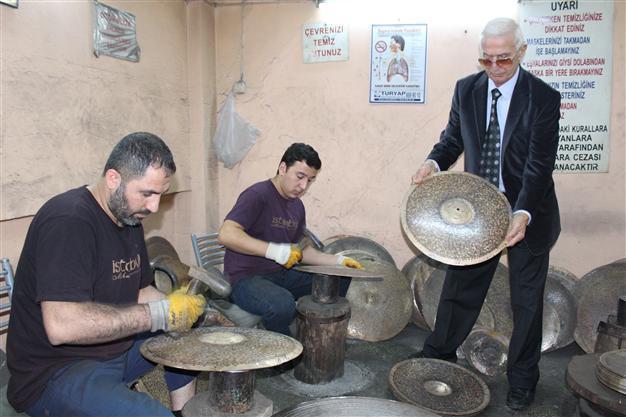Zildjian family apprentice still making historic cymbals in Istanbul
ISTANBUL

AA Photo
Mehmet Tamdeğer, once an errand boy for the world famous Zildjian cymbal makers, keeps hammering out his special-formula of precious copper to produce the drum component for artists around the globe in a moderate atelier in Istanbul.
The “Istanbul” brand, known as a historic offshoot Zildjian, has weathered both time and its industrial rivals, in the hands of Tamdeğer, who started the business at 10, helping the legendary Mikael Zildjian in the 1950s.
“As a gift of God, I lived very close to the [Zildjian] factory in Samatya. I spent my childhood there,” he said in a recent interview with Anadolu Agency.
“My dad died when I was 10 and my family was sort of shaken. I was employed at the Zildjian factory, where I worked until 1978. Master Zildjian was always by my side and I learned everything from him,” he said.
The story of Zildjian goes all the way back to the 17th century.
Avedis Zildjian I was an Armenian alchemist in Istanbul. “While attempting to create gold by combining base metals, he discovered an alloy of copper, tin, and traces of silver with unique sound qualities,” notes the website of Zildjian cymbals.
“In 1618, Avedis used his secret alloy to create cymbals of spectacular clarity and power. The sound of the instruments was so extraordinary that the sultan invited Avedis to live at court [Topkapı Palace] and make cymbals for the Sultan’s elite Janissary Bands,” the site states.
As Avedis’ reputation grew, the Sultan gave him the name “Zildjian” in Armenian, a word meaning “son of the cymbal maker.”
In 1623, Avedis was granted permission to leave the palace in order to start his own business in Samatya.
The Zildjian company moved to the United States in 1929, while Avedis III moved the Zildjian factory to Quincy, Massachusetts, and then to its current location in nearby Norwell for Zildjian’s 350th anniversary.
On Dec. 20, 2010, Avedis Zildjian Company merged with Vic Firth, with both companies continuing to operate autonomously.
“Not only are Zildjians the best cymbals, they’re the only cymbals. End of story,” said Metallica drummer Lars Ulrich. Others that use the cymbals include percussion guru Trilok Gurtu, Dream Theater’s Mike Mangini, Ringo Star of The Beatles, Charlie Watts of the Rolling Stones, Nick Mason of Pink Floyd, Ginger Baker of Cream and others.
As one arm of the Zildjian family was building a huge brand in the U.S., those who remained in Turkey continued making cymbals until 1978, when Mikael Zildjian died.
Tamdeğer said he felt desperate after his master’s death. Following two years of jewelry business in Kuwait, he re-founded the old business with his former colleague, Agop Tomurcuk, another Turkish-Armenian.
“[Agop] was also jobless like me for a long time. We started with shortages. I sold my Volkswagen but the money was still too little for starting capital. We bought machinery on loan. We faced many hardships. As a gift, famous American drummer Billy Heart dropped by our facility in [Istanbul’s] Bağcılar.
We had an office of a few square meters. He stayed there for hours, inspecting the cymbals. He was confused about which one to buy. ‘Now I am leaving but look at who else will come here,’ he said.”
All cymbals are unique, according to Tamdeğer. “We produce cymbals for pop, jazz and rock genres. We have about 200 products,” he said.
Agop, the owner of Istanbul Agop Cymbals, passed away in 1996. Co-brand “Istanbul Mehmet” today exports cymbals to 40 countries and is used by musicians such as Tony Williams, Carmine Appice, Micke Backelin, Horacio El Negro Hernandez, Carmine Appice, Erik Smith, Elvin Jones, Kiko Freitas, Snowy Shaw and Jack DeJohnette.
